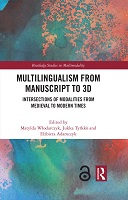Chapter 5 Multimodal and Multilingual Practices in Late Medieval English Calendars
Proposal review
Author(s)
Peikola, Matti
Varila, Mari-Liisa
Language
EnglishAbstract
This chapter examines the multimodal and multilingual features of 31 calendars in religious and scientific/utilitarian manuscripts produced in England ca 1300–1550 and containing at least some vernacular textual material. The analysis is guided by questions concerning the genre properties of the calendars and processes of vernacularisation. The analysis is targeted at macro-level compositional elements as well as micro-level features of individual calendar entries. The socio-pragmatic context is monitored by paying attention to situational constraints that may have influenced the use of multimodal and multilingual resources.
The study brings up multilingual and multimodal patterns that reflect the conventions of the genre while also highlighting possible functional differences underlying producers’ decisions concerning language choice and visual design/composition. The findings indicate that manuscript context played an important role in what information came to be included in the calendar and how it was subsequently shaped. Some calendars can best be described as generic hybrids between calendars and other tabular genres. The use of a diachronic dataset distributed into 25-year date groups reveals some changes in the genre features of the English calendars during the ca 250 years’ span.
Keywords
modalities; modalities of communication; multilingual communication; historical communication; multimodal resources; multimodality; semiotic resourcesDOI
10.4324/9781003166634-6ISBN
9780367763596, 9780367763626, 9781003166634Publisher
Taylor & FrancisPublisher website
https://taylorandfrancis.com/Publication date and place
2023Imprint
RoutledgeClassification
Language: reference and general
Linguistics


 Download
Download